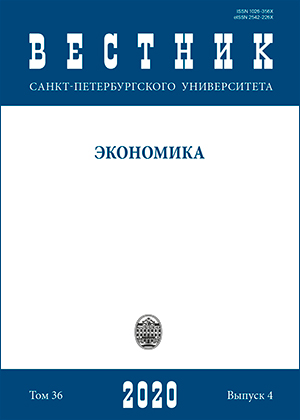The Role of the Embargo in the Russia’s Agricultural Trade Policy
Аннотация
Данная статья вносит вклад в методологию оценки нетарифных мер. Использовались пропорции между параметрами двух гравитационных уравнений, описывающих ситуацию до и после эмбарго. Соотношение импорта за два сопоставимых года не было таким же, как соотношение ВВП между двумя группами торговых партнеров, одной из которых были партнеры по свободной торговле, а другой - остальные страны мира. Эта разница, которая в отсутствие эмбарго может объясняться воздействием таможенного тарифа, поскольку предполагалось, что во всех случаях применяются санитарные и фитосанитарные меры, при наличии эмбарго усиливалась с появление нового торгового барьера. Это позволяет количественно оценить торговые запреты.
Нулевая гипотеза работы была следующей: влияние избирательного эмбарго на импорт невелико и не превосходит влияние тарифных и фитосанитарных мер. Иными словами, режим импортозамещения (также известный как специальная экономическая мера), введенный в 2014 году, не доминирует над обычным торговым регулированием. Нулевая гипотеза отвергается. Проанализировав динамику торговых барьеров, нулевую гипотезу можно уточнить следующим образом: среди прочих торговых барьеров торговое эмбарго стало доминирующей причиной эффекта импортозамещения, возникшего в 2016 году, когда эмбарго имело наивысший уровень, но эта позиция нестабильна.
Ключевые слова:
специальная экономическая мера, торговое эмбарго, нетарифные меры, импортозамещение, гравитационное уравнение, международная торговля
Скачивания
Библиографические ссылки
Askari H., Forrer J., Teegen H. and Yang J. (2003) Case Studies of U.S. Economic Sanctions: The Chinese, Cuban, and Iranian Experiences. Praeger. 304 p.
Bora B. (2005) The Quantification and Impact of Non-Tariff Measures. In: The Effects of Non-Tariff Measures and Trade Facilitation. APEC Secretariat and World Scientific Publishing Co. Pte. Ltd. 674 p.
Chaney T. (2017) The Gravity Equation in International Trade: An Explanation. Copyright The University of Chicago. Preprint.
Czaga P. (2005) OECD Trade Policy Studies. The Role of Non-Tariff Barriers in World Trade. In: Looking Beyond Tariffs. Import Prohibitions and Quotas. OECD Publications. 304 p.
Deardorff, A. V. and Stern R. M. (1998) Measurement of Nontariff Barriers. University of Michigan Press. 152 p.
Dee P. and Ferrantino M. (2005) Introduction. In: The Effects of Non-Tariff Measures and Trade Facilitation. APEC Secretariat and World Scientific Publishing Co. Pte. Ltd. 674 p.
Fagiolo G. J. (2010) The International-Trade Network: Gravity Equations and Topological Properties. Econ Interact Coord, no.5. pp. 1-25. URL: https://doi.org/10.1007/s11403-010-0061-y
Head K. and Mayer T. (2013) Gravity Equations: Workhorse, Toolkit and Cookbook. CEPII Working Paper, no.27. 70 p. URL: http://www.cepii.fr/pdf_pub/wp/2013/wp2013-27.pdf
Helpman E. (2017) Understanding Global Trade. Moscow. University of Gaidar Institute. 312 p.
Herrmann-Pillath C. (2006) The True Story of Wine and Cloth, or: Building Blocks of an Evolutionary Political Economy of International Trade. J Evol Econ, no.16. pp. 383-417.
Hoekman B. (1995) Assessing the General Agreement on Trade In Services. In: Martin W. and Winters L. A. eds. The Uruguay round and the developing economies. World Bank Discussion Paper.307 p.
Hufbauer G. C., Schott J. J., Elliott K. A. and Oegg B. (2009) Economic Sanctions Reconsidered. Third Edition. Peterson Institute of International Economics. 248 p.
Korhonen I, Heli S. and Solanko L. (2018) Sanctions, Counter-Sanctions and Russia − Effects on Economy, Trade and Finance. Bank of Finland (BOFIT) Policy Brief, no. 4. 30 May. URL: https://helda.helsinki.fi/bof/bitstream/handle/123456789/15510/bpb0418.pdf?sequence=1
Kutlina-Dimitrova Z. (2015) The Economic Impact of the Russian Import Ban: a CGE Analysis. Trade. Chief economist note, Issue 3. URL:https://trade.ec.europa.eu/doclib/docs/2015/december/tradoc_154025.pdf
Livshitz V. N. and Livshitz S.V. (2011) Systems Analysis of Russia 's Non-Stationary Economy (1992-2010): Market Reforms, Crisis, Investment Policy. 2nd ed. Moscow: Maroseyka. 510 p.
Mitsuyo A. (2005) Estimating Tariff Equivalents of Core and Non-Core Non-Tariff Measures in the APEC Member Economies. In: The Effects of Non-Tariff Measures and Trade Facilitation. APEC Secretariat and World Scientific Publishing Co. Pte. Ltd. 674 p.
Oranen T. (2017) Russian Counter-sanctions and Trade Deflection: Evidence from Finland. Master’s essay (First year). Department of Economics Lund University. URL: http://lup.lub.lu.se/luur/download?func=downloadFile&recordOId=8928030&fileOId=8928031
Rauch F. (2016) The Geometry of the Distance Coefficient in Gravity Equations in International Trade. Review of International Economics, no. 24(5). pp.1167-1177.
Serrano R. and Pinilla V. (2012) The Long-Run Decline in the Share of Agricultural and Food Products in International Trade: a Gravity Equation Approach to its Causes.Applied Economics, no. 44:32. pp. 4199-4210.
Shagaida N.I. and Uzun V.J. (2017) Trends and Main Challenges of the Agricultural Sector of Russia: Analytical Report. Center for Strategic Development. Moscow. 88p. URL: https://www.csr.ru/wp-content/uploads/2017/11/Doklad_selskoe_hozyai-stvo_veb.pdf
Tinbergen J. (1962) Shaping the World Economy. New York: Twentieth Century Fund.
Trade Statistics in Policymaking. (2009) A Handbook of Commonly Used Trade Indices and Indicators. Revised Edition. UN Economic and Social Commission for Asia and the Passific. URL: https://www.unescap.org/sites/default/files/0%20-%20Full%20Report_27.pdf
Zhiryaeva E.V. and Naumov V.N. (2018) Global and Glocal Trade Streams Assessment in the Subjects of the Northwestern Federal District Trade.Management Consulting. no. 5. pp. 113-129. URL: https://www.acjournal.ru/jour/article/view/863/858
Zhiryaeva E.V. (2018) Regulation of Foreign Economic Activity at the Regional Level in Global Conditions of the WTO. The abstract of the thesis for a degree of the Doctor of Economics. St. Petersburg. 39 p. URL: https://disser.spbu.ru/files/disser2/1586/aftoreferat/BzvY3G3YCY.pdf
Опубликован
Как цитировать
Выпуск
Раздел
Лицензия
Статьи журнала «Вестник Санкт-Петербургского университета. Экономика» находятся в открытом доступе и распространяются в соответствии с условиями Лицензионного Договора с Санкт-Петербургским государственным университетом, который бесплатно предоставляет авторам неограниченное распространение и самостоятельное архивирование.






